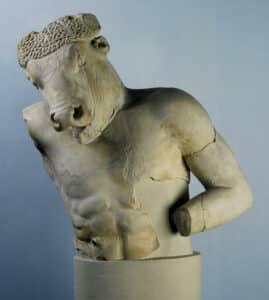Into the Labyrinth
Sixth Former, Alanah Keane, reviews a Classics trip to the Ashmolean Museum in Oxford to see the current Labyrinth: Knossos, Myth & Reality exhibition.
On Thursday 27th April, those studying Classics in the Sixth Form, visited the Labyrinth exhibition at the Ashmolean Museum in Oxford. The exhibition mainly highlighted the palace of Knossos, the legend of the labyrinth supposedly lying beneath it, and the Greek myth of the minotaur, (a man with the head of a bull), said to have been trapped within the labyrinth. As someone who has solely studied Latin, the opportunity to broaden my knowledge about a Greek myth was much anticipated.
 Many fantastic artefacts were on display including ceramics depicting Theseus slaying the minotaur, and a marble sculpture of the minotaur. For those who were not particularly familiar with the story, a projected cartoon provided the vital components. The story of Theseus and the minotaur begins with the death of King Minos’ son while he was in Athens. King Minos was outraged and demanded that King Aegeus of Athens must send seven men and seven women every year to the labyrinth as sacrifices. One year Theseus, the son of King Aegeus, decided to be one of the seven men sent, so that he may kill the minotaur and put an end to the sacrifices. When Theseus got to Crete he met Ariadne, the daughter of King Minos. They fell in love, and she gave Theseus string to unravel as he went into the labyrinth, so he could find his way out once the beast had been slain. Theseus was able to kill the minotaur and follow the string to the exit. Theseus then left Crete with Ariadne and began his journey back to Athens. However, on the way the stopped at the island of Naxos. It was there that Theseus abandoned Ariadne, where she was discovered by the god Dionysus, who took a great liking to her.
Many fantastic artefacts were on display including ceramics depicting Theseus slaying the minotaur, and a marble sculpture of the minotaur. For those who were not particularly familiar with the story, a projected cartoon provided the vital components. The story of Theseus and the minotaur begins with the death of King Minos’ son while he was in Athens. King Minos was outraged and demanded that King Aegeus of Athens must send seven men and seven women every year to the labyrinth as sacrifices. One year Theseus, the son of King Aegeus, decided to be one of the seven men sent, so that he may kill the minotaur and put an end to the sacrifices. When Theseus got to Crete he met Ariadne, the daughter of King Minos. They fell in love, and she gave Theseus string to unravel as he went into the labyrinth, so he could find his way out once the beast had been slain. Theseus was able to kill the minotaur and follow the string to the exit. Theseus then left Crete with Ariadne and began his journey back to Athens. However, on the way the stopped at the island of Naxos. It was there that Theseus abandoned Ariadne, where she was discovered by the god Dionysus, who took a great liking to her.
However, the exhibition was not purely about the interpretations of the myth of the labyrinth and minotaur, and many artefacts featured were the discoveries of a 20th century excavation at Knossos, trying to uncover the truth about the maze. A clip displaying with detail the palace of Knossos from the video game Assassin’s Creed Odyssey, was also shown and provided an almost 3-D experience.
After the exhibition, we had a chance to wander around the rest of the museum to observe other artefacts that we might take interest in. My personal favourites were the immense tapestries, covering entire walls. The level of detail, and skilled embroidery are fascinating to observe up close. A special thanks to Mr Sinclair for organizing this trip.
